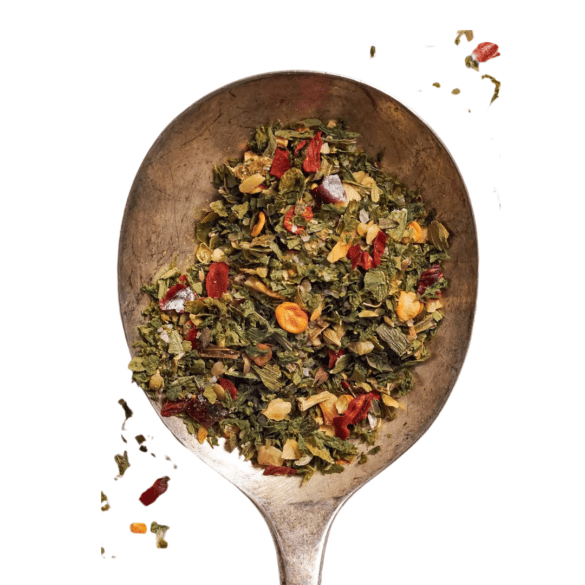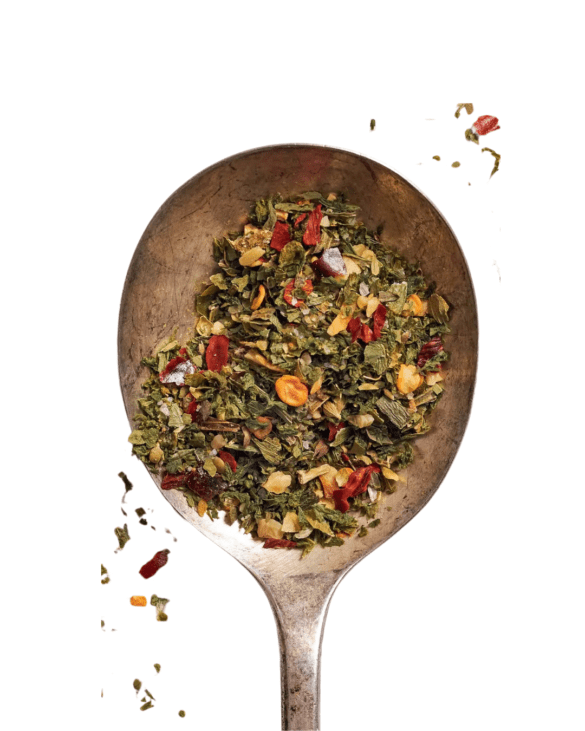In the hustle and bustle of our daily lives, whipping up a fresh batch of this green gold for every meal isn’t always feasible. That’s where the genius of Chimichurri seasoning comes in, and I’m thrilled to share my journey and recipe for crafting this versatile and downright delicious seasoning blend right at home.
Table of Contents
How to make Chimichurri Seasoning
Chimichurri seasoning is a dry spice blend inspired by the traditional chimichurri sauce from Argentina and Uruguay. The sauce typically consists of fresh herbs, garlic, vinegar, and oil, but the seasoning version is a dried blend of the key flavors.
Ingredients:
To make a batch of Chimichurri seasoning that can be stored and used as needed, you’ll need the following dry ingredients:
- 1/4 cup dried parsley
- 2 tablespoons dried oregano
- 1 tablespoon garlic powder
- 1 tablespoon onion powder
- 1 teaspoon red pepper flakes (adjust to your preferred level of heat)
- 1 teaspoon fine sea salt (or to taste)
- 1/2 teaspoon freshly ground black pepper
- Optional: 1/2 teaspoon smoked paprika for a smoky note
Equipment:
- Mixing bowl
- Whisk or spoon
- Spice grinder (optional for a finer blend)
- Airtight container for storage
Instructions:
- Combine Dry Herbs: Add the dried parsley and dried oregano to a mixing bowl. If your herbs are leafy and you prefer a finer seasoning, give them a quick blitz in a spice grinder, but do not over-process; you want some texture.
- Add Flavors: Sprinkle the garlic powder and onion powder over the herbs, which add depth and a savory foundation to the Chimichurri seasoning.
- Spice It Up: Sprinkle in the red pepper flakes. Remember, a little goes a long way, so you can adjust the heat level according to your taste. If you’re adding smoked paprika, now is the time.
- Season: Add the fine sea salt, which is crucial for enhancing all the other flavors, and the freshly ground black pepper for a little kick.
- Mix It Well: Thoroughly mix all the ingredients until well combined with a whisk or a spoon. If you’re using a spice grinder, pulse a few times to blend everything, but be careful not to turn it into a fine powder.
- Taste and Adjust: Taste your blend and adjust any of the seasonings to your preference. Need more heat? Add more red pepper flakes. Want it saltier? Sprinkle in a bit more sea salt.
- Store for Freshness: Transfer your Chimichurri seasoning to an airtight container. Label it with the date so you can keep track of its freshness. Stored in a cool, dry place, your seasoning should stay fresh for up to 3 months.
Tips:
- Using Fresh Herbs: To make a fresh sauce with this seasoning blend, simply mix it with olive oil and red wine vinegar. Allow it to sit for at least 10 minutes to let the flavors meld.
- Toasting Spices: For an even deeper flavor, you can lightly toast the dried herbs in a dry skillet until fragrant before grinding them. This extra step enhances their essential oils but be careful not to burn them.
- Herb Choice: Make sure your dried herbs are not too old, as they lose their potency over time. Fresh, good-quality herbs will significantly improve the flavor of your seasoning.
- Customization: Feel free to customize this seasoning to your tastes. Some like to add a bit of dried thyme, cilantro, or even a touch of lemon zest to their blend for an extra zing.
What to serve with
Chimichurri seasoning is exceptionally versatile and can elevate a wide array of dishes with its zesty and herby profile. Here’s an inspiring guide on what to serve with your homemade Chimichurri seasoning, offering a variety of ideas that cater to different culinary contexts from mains to sides.
Main Courses
- Grilled Steaks: The classic Argentinian pairing is steak and chimichurri. Use your dry seasoning as a rub before grilling steaks, or mix it into a wet chimichurri sauce to serve over the top for a vibrant, flavor-rich topping.
- Roast Chicken: Before roasting a whole chicken, rub it with olive oil and liberally apply the Chimichurri seasoning. The herbs and spices will infuse the chicken with incredible flavor.
- Seafood pairs wonderfully with fish and shrimp. Sprinkle the seasoning on seafood before grilling or baking, or mix it into a marinade to enhance the delicate flavors of the sea.
- Lamb and Pork: Before cooking, apply the Chimichurri seasoning as a dry marinade for lamb chops or pork ribs. The bold flavors of the herbs balance beautifully with the rich meat.
Vegetarian and Vegan Dishes
- Grilled Vegetables: Toss vegetables like bell peppers, zucchini, and mushrooms in olive oil and Chimichurri seasoning before grilling or roasting for a delicious side or vegetarian main course.
- Tofu and Tempeh: Marinate slices of tofu or tempeh in a wet paste made from the seasoning blended with oil and vinegar, then bake or fry. This gives a protein-rich vegan dish a robust flavor.
- Legumes and Beans: Stir the seasoning into cooked beans, lentils, or chickpeas for a flavorful addition to salads, wraps, or as a wholesome component in rice bowls.
Sides and Salads
- Potatoes: Whether roasted, mashed, or made into potato salad, potatoes and Chimichurri make a perfect match. Mix the seasoning into your cooking method of choice for a burst of flavor.
- Rice and Quinoa: Sprinkle seasoning into the cooking water of rice, quinoa, or any grain to lightly infuse them with the Chimichurri flavor profile.
- Bread Spreads: Mix Chimichurri seasoning with softened butter or a vegan spread to create a delicious compound butter. Spread it on bread, rolls, or use it to top corn on the cob.
Appetizers and Quick Snacks
- Dips: Mix the seasoning into Greek yogurt, sour cream, or avocado mash for a quick and flavorful dip.
- Popcorn: Sprinkle some Chimichurri seasoning over freshly popped popcorn for an instant flavor upgrade.
- Bruschetta: For a quick appetizer, top toasted slices of baguette with tomatoes, basil, and a sprinkle of Chimichurri seasoning.
Ingredients Substitutes
Chimichurri seasoning, which originated in Argentine and Uruguayan cuisine, is known for its vivid, tangy, and herbaceous character. It typically features ingredients like parsley, oregano, garlic, chili, vinegar, and oil. However, availability or dietary restrictions may necessitate the use of substitutes.
1. Parsley
Substitute: Cilantro is an excellent alternative, offering a similarly fresh and slightly citrusy profile. For those who don’t enjoy cilantro, a mix of baby spinach and a small amount of arugula can mimic parsley’s color and provide a somewhat similar bitter edge.
2. Oregano
Substitute: Marjoram is closely related to oregano but has a sweeter, milder taste. It makes an excellent substitute. Thyme can also be used as an alternative, providing a different but complementary earthiness.
3. Garlic
Substitute: For those who cannot consume garlic, asafoetida (hing) powder offers a similar pungency in much smaller quantities. Garlic chives or green garlic (when in season) can also substitute for fresh garlic’s aromatic qualities but with a milder taste.
4. Chili (Red Pepper Flakes)
A variety of substitutes can adjust the heat or omit it entirely. For a milder flavor, paprika can offer the color and some of the sweetness without the heat. For a spicier kick, cayenne pepper or finely chopped fresh jalapeños or serrano peppers can be used. To remove heat altogether while retaining depth, bell pepper powder or sweet paprika can be used.
5. Vinegar
Substitute: The acidic component is essential for chimichurri’s zesty flavor. Lemon or lime juice can be a perfect substitute, offering freshness and acidity. Different vinegars, like white wine vinegar or apple cider vinegar, can also be used depending on availability or taste preference.
6. Oil
Substitute: While olive oil is traditionally used for its flavor, any neutral oil like avocado or even grapeseed oil can be employed depending on dietary restrictions or flavor profile preferences. These oils offer a more neutral base, allowing the herbs and spices to shine through more prominently.
7. Fresh vs. Dried Herbs
In the absence of fresh herbs, dried herbs can be utilized, keeping in mind the conversion ratio. Typically, one part of dried herbs equates to three parts of fresh herbs. The flavor profile might change subtly, with dried herbs having a more concentrated essence.
Final Thoughts
This Chimichurri seasoning recipe offers the perfect fusion of Argentine flair and homemade convenience. Sprinkle it on grilled meats, stir it into marinades, or add a dash to your roasted vegetables for a quick trip to flavor town.

Ingredients
- 1/4 cup dried parsley
- 2 tablespoons dried oregano
- 1 tablespoon garlic powder
- 1 tablespoon onion powder
- 1 teaspoon red pepper flakes
- 1 teaspoon fine sea salt (or to taste)
- 1/2 teaspoon freshly ground black pepper
- Optional: 1/2 teaspoon smoked paprika for a smoky note
Instructions
Combine dry herbs:
Add dried parsley and oregano to a bowl. For a finer texture, pulse briefly in a spice grinder, but don’t over-process.
Add flavors:
Sprinkle in garlic powder and onion powder to build a savory base.
Spice it up:
Add red pepper flakes for heat. If using smoked paprika, mix it in now.
Season:
Add fine sea salt to enhance flavors and freshly ground black pepper for a kick.
Mix it well:
Whisk or stir until evenly combined. If using a grinder, pulse lightly, avoiding a fine powder.
Taste and adjust:
Check flavor and tweak to your liking. Add more flakes for heat or more salt if needed.
Store for freshness:
Transfer to an airtight container, label with the date, and keep in a cool, dry place. Stays fresh up to 3 months.
